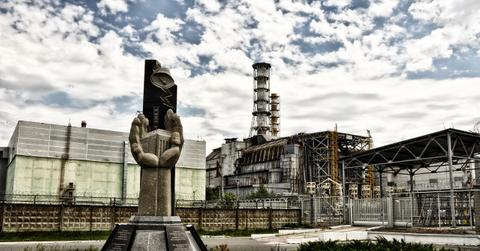Chernobyl's Nuclear Disaster Site Is Now A Solar Farm
The Ukrainian government has transformed the former nuclear power plant into a functioning solar-electric farm.
Updated Oct. 8 2018, 1:00 p.m. ET
Chernobyl is the infamous site of a nuclear power plant that exploded in 1986, killing over 31 people within the first three months and exposing thousands more to potentially lethal radiation. But the abandoned area around the former facility will now serve a new purpose, as home to a 1 megawatt solar power farm.
Solar Chernobyl officially launched the new farm on Friday, October 5. The site is located around 300 feet from the enormous arch where the damaged nuclear reactor is contained, according to Forbes. This new solar plant has the capacity to power about 2,000 households with its current 4-acre facility, but the ultimate goal is to scale up to 100 megawatts — and with that kind of energy, the farm could provide electricity to 200,000 homes.
"Today we are connecting the station to the power system of Ukraine," Yevgen Varyagin, the head of Solar Chernobyl, said at the opening ceremony.
Solar Chernobyl. Presentation.Posted by Solar Chernobyl on Saturday, October 6, 2018
Only the Fukushima Daiichi nuclear disaster of 2011 and what took place in Chernobyl qualify as a Level 7 disaster, the highest classification for an energy accident. A flawed reactor design with workers that weren’t trained well for a safety test proved to be fatal. Steam caused multiple explosions and fire rapidly spread over the area.
Decades later, Chernobyl now features safety zones with 19 square miles around the disaster still blocked off. The site of the explosion can't be safely occupied by humans for another 24,000 years.
The Ukrainian firm Rodina Energy Group and German company Enerparc Ag collaborated on the $1.2 million Solar Chernobyl project. Both companies are capitalizing off Ukraine's development of the land, which is now selling at extremely cheap prices. While the area isn’t safe for farming, it creates an ideal situation for renewable energy as power lines are still connected in the evacuated zone. The Ukrainian government is also paying well for the energy generated on the Chernobyl site — as much as 50 percent above European averages, experts claim.
"Bit by bit we want to optimize the Chernobyl zone," Evgeny Variagin, CEO of Rodina Energy, told Bloomberg. "It shouldn’t be a black hole in the middle of Ukraine."
Although 100 megawatts of solar power is an exciting possibility, that’s only a small fraction of the nuclear reactor’s capacity. There were four total active reactors with a gigawatt capacity each, and two more were under development at the time of the explosion. Those were halted three years after the accident.
Rodina Energy and Enerpac AG aren't the only power companies developing in the area. According to Bloomberg, firms from France and China are interested in building solar farms on the redeveloped land. In particular, Engie SA in France is "conducting a pre-feasibility test with a gigawatt-sized project in mind." Ukraine's minister of ecology has studied the area since July of 2016 to see if these projects could work.
GCL System Integration Technology Co. Ltd. and China National Complete Engineering Corp. have also expressed interest in bringing more solar to Chernobyl.
